When people start a vision improvement program, they are often fixated on seeing clearer and clearer every single day, as if it’s a race they have to win. Or they rush to get out of their strong glasses and see just as well without them, even though they’ve worn them for years.
I see 2 problems with this mindset. First, the emphasis on getting to 20/20 clarity as fast as possible is often unrealistic, and can lead to disappointment and giving up completely. Second, you’re ignoring all the other aspects of a healthy visual system, where you can often observe faster progress than by only measuring the clarity of the eye chart.
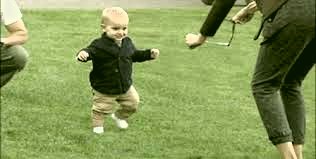
If you start wearing a weaker prescription which lets you see 20/30 or 20/40 so you can drive safely, you may immediately notice your eyes and face relaxing. You’re not being forced to look at the world with that stark artificial super-clarity, which makes you want to back away. You can exhale fully now and let the tension go, tension you didn’t even know you were carrying.
Along this same line, if you do what you can without your glasses, as long as you feel safe, you may notice your overall feeling of ease growing, in both your body and your mind. Please make sure you are legal when driving! Yet we often don’t need our full correction when going for a walk, or cleaning the house. When I first started doing simple safe tasks without my strong -10 contact lenses, I felt so free! It’s like you’d let me out of a cage I hadn’t realized was around me.
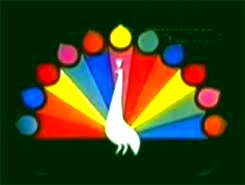
As you observe your world with more alive eyes, pay attention to color. Many people report colors are more vivid, and subtle shades more distinct. This is a great game to play with children who don’t know their letters yet so can’t use an eye chart, identifying the different hues of red and pink and orange. Spring flowers are a good place to practice. Which buds look ready to pop, which are still branch-brown or pale yellowish, and which are vibrant bright ready-to-burst-any-minute shamrock green?
What can you see now which was a problem before? I used to be afraid that if I dropped something small, like a vitamin pill or an earring, I’d never find it. It was like it had been swallowed up by a black hole! I had no confidence in my ability to see something unless it was big. Now I don’t even think about it, much less worry about it and criticize myself for being defective. If I drop something, I reach down and pick it up, then go on with my life.
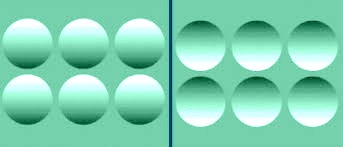
Another aspect of healthy vision which is fun to notice is depth. Like color, you’ll find more places to play with this outdoors. Notice the differing depths in the houses in your neighborhood, one set a bit back from another, the steps projecting out in front, the air conditioner poking out above a window. A teacher of mine, Peter Grunwald who developed the Eyebody Method of vision improvement, taught that one of the main practices to help near-sighted people improve is focusing on depth. You can read an old post about the intention to see depth here.
So appreciate the signs that you’re improving your vision, at your own pace and on your own schedule. Your eyes and mind are happier and more relaxed, and you get fewer headaches. You’ll see greater clarity on the eye chart in time, especially if you don’t chase it, instead let it come to you. Like the child in the photo, one baby step at a time will eventually get you there. Baby steps are better than no steps!
I wore strong glasses, then contact lenses, from age 5 into my 40s. While making many mistakes, eventually l learned how to improve the way I use my eyes and to see in a more relaxed, healthy manner. It is my pleasure to coach others to do the same. Visit me at https://NancyLNeff.com.
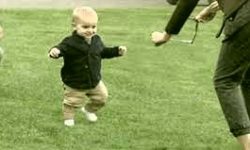
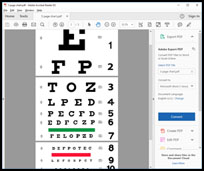
Thanks, Nancy. I much appreciate the further clarification.
Many times now I feel a sort of lightness or freedom on my walks due to the apparent improving situation. I wasn’t concerned about my inability to “rack focus” like a camera, but I appreciate the confirmation that my eyes are functioning (relatively) normally. I think my ability to quickly shift focus will improve. I’ll continue to practice on my walks and whenever else I think to do it.
This a good time for me. Several important visual concepts are coming together–Central Fixation among them–and the combined understanding helps a lot. It’s important to the way I think and learn that I have a conceptual basis for what I’m attempting. The concepts you discuss and teach are very helpful, and at this point I have real hope of improvement after 35 years (ugh!) of thinking I was doomed. Too good!
Also, in line with your advice, I feel less affected by “labels and conditions” related to whatever’s happening with my vision. I have a spiritual view of health and healing, and your recent comments help push that Awareness forward. Thanks, and I’ll let you know if anything truly “eventful” happens.
Tom
I want to “report back” on my progress. For a couple of weeks now I’ve been dutifully and systematically combining SEEING DEPTH with OPEN FOCUS during my Vision Walks. I’m lucky to be able to walk through a forested area during the Winter. The bare branches provide LOTS of opportunity to focus, shift focus and notice the depth in the scenery passing by.
I’m really ENJOYING it, and (fingers crossed) it REALLY does seem to be improving my vision. Instead of my eyes feeling “tight or hard or rigid” at times they feel remarkably FREE or maybe LOOSE – as though their swiveling effortlessly, bathed in some very light lubricant. The best way I can describe it…ha!.
One limitation I find, and this is not a bad thing: So far I am NOT able to expand my DEPTH OF FIELD as can be done with a camera . Adjusting the camera’s Aperture can bring a short or long depth of field into focus (so an object in the foreground and background can BOTH be in focus). So far I’m not able to do that at all. I’ve tried, but find I can only bring ONE object at ONE distance into “focus” (sort of, ha!) at a time. Perhaps that’s normal for the human eye…
In any case, I’m making progress. THANK YOU, NANCY!
Tom, 2 comments. First, anything which you enjoy seeing, like the bare branches on your vision walks, will help your visual channel. You are teaching your eyes and brain that it’s fun to see well, so they’ll want to do more of that.
Second, the human eye is designed to see only a single point at a time. (Go reread the central fixation article.) People with very good vision may think they’re seeing near and far objects “at the same time”, when they’re really focusing on one, then shifting to the other and focusing on that, then shifting again and focusing there, so rapidly they’re not aware of it being separate actions. Part of vision improvement consists of automatic shifting and focusing naturally getting quicker.
P.S. I just read your linked article, “Intention For Seeing Depth.” YOW.
I’m an artist, so my vision anomaly has been causing me a lot of trouble. One thing I’ve noticed since beginning my vision improvement quest is that I tend to NOT actually LOOK at things, just as you describe in the linked article.
Per your recommendations, I take “vision walks” frequently. TODAY I’ll give special emphasis to DEPTH PERCEPTION and FIELD OF VIEW – just like Fstops and aperture in a camera. I think you’ve given me/us yet another very helpful insight. Thanks.
Great! The teacher in me loves it when someone takes what I say and applies it to improve his own situation. Once I realized how lacking my own awareness of depth was, and started focusing more on it, the world came alive. It was like I’d been living in a 2D Flatland before. Vision improvement really did open up a new world for me.
Vision improvement really did open up a new world for me.
Nancy, you’re so on target. And Cyber, you too! It’s funny, Nancy, that you mentioned a noticeable relaxation of the eyes and face when “going without” or with a less-strong lens. I started noticing exactly that about two weeks ago. Interesting coincidence, if you believe in those ;]
I’m finding the concept of “Open Focus” ala Jacob Lieberman (recommended by David Kiesling) to be very helpful. I tend to “stare a hole in” whatever my focus happens to be, and developing the awareness to replace that with an intentional “soft gaze” that takes in the entire scene seems to be helping a lot.
On a related note (and this may sound like nonsense), when I perform Dr Bates’ “Long Swing” I swear I can see everything CLEARLY(!!!) but of course it’s all flowing past and I cannot actually focus on any of it. Still, I have the very strong impression that edges are sharp and colors are intense. It gives me real hope.
I think my eyes learned to suppress the saccade movements, and I think both The Long Swing and Open Focus encourage the natural saccade movement. I hope and pray that with time and awareness my eyes will “loosen up” and return to their natural, God-intended saccade movements.
Thanks, Nancy, for your very helpful insights and encouragement.
Wonderful, Tom! And yes, that fleeting glimpse of clarity is such a tease, which evaporates immediately if we chase it. I think one of my biggest lessons in vision improvement is to just let the view be as it is and see/accept it that way, without trying to wrestle it into greater clarity. Yes, keep noticing, and appreciating. And thanks for the comment!
Cyber, good for you for your self-awareness! Same for me. I have become much more self-confident and happy without trying from my vision improvement work, now able to look people in the eye and really see and hear them, without feeling exposed and vulnerable. I think glasses can hide your true feelings, and the Real You, maybe even from yourself. Congratulations!
I used to be really confident but lost that confidence after years of being bullied. This had changed my personality drastically for the worse. Instead of being able to do what I wanted I was constantly afraid of being judged for everything and did not dare to do much in public. But some time after starting NVI I noticed my personality had changed to become much more like what it used to be. Nowadays I am again confident and can do what I want without fear. This makes life better for me and for many of those around me. (Emotionally weak people are more of a burden and less of a help in general.)
I do not know if it is related since I changed more habits e.g. my diet, so this is not a good experiment to base conclusions on. But if someone used be really confident but lost that confidence as a child and is myopic, then he should maybe consider trying Bates’ method of NVI because that might have been what helped me recover emotionally.
Asha, the same principles apply, whether you’ve had Lasik or not. Focus on relaxation and easy movement, noticing what you’re seeing and how you feel about it. I believe the body, mind, and eyes know very well how to heal if we give them the right environment and support.
What are the possibilities for improvement for those who already have had a lasik operation? How can they improve their vision?